Pond Chemistry
The importance of regularly testing your ponds water quality can not be understated, it is a common misconception that if the pond’s water is clear, it is also clean and viable. However, this is usually not the case.
It’s important for every pond "hobbyist" to know that biological and chemical changes in your water are not visible. Only through regular testing can the true quality of water be determined. Poor water quality typically results in health problems that can be avoided with proper care.
When establishing a new pond, you should test the water weekly for the first four to six weeks, regardless of what kind of aquatic life might be present. The most importsant parameters to test for are ammonia, nitrite and nitrate during this period, because the pond needs to establish a natural biofilter. After this initial period, the pond can be tested monthly, provided there are no widespread external influences on the pond. If you notice unusual odors, aquatic sickness or death of aquatic life, test your water immediately. When testing, always take a water sample about 20 centimeters below the surface.
What Parameters to keep an eye on:
Nitrite is the primary breakdown product of ammonia, and as it increases, it is very poisonous to fish. It is a skin irritant and will prevent fish from absorbing oxygen from the water. High nitrite level concentrations in the pond can be reduced by regular, partial water changes. Nitrite is an odorless, colorless substance, and the ideal level in your water should be zero, with acceptable levels up to 0.25 ppm NO2.
Nitrate is produced from breaking down the nitrite through bacteria action. Nitrate is not especially harmful to freshwater fish, but it is a strong plant fertilizer and can cause the growth of algae. The levels of nitrate should be controlled to help reduce algae blooms. The optimal level of nitrate in water should be between 20 to 60 ppm NO3, and this can be controlled through partial water changes. It is eventually broken down into nitrogen.
pH is a measure of acidity and can be separated into three categories: pH 0 — 6.99 (acidic), pH 7.0 (neutral) and pH 7.01 — 14.0 (alkaline). In general, pH is not a problem for ponds, but it influences the toxicity and concentration of ammonia. Water above a pH of 7.01 with increased water temperatures causes the presence of more free ammonia. The higher the pH and water temperature, the greater the percentage of free ammonia. The ideal pH range is 6.8 to 7.8 for pond water.
Chlorine (free and combined) is widely used in the disinfection process of tap water. The acceptable concentration in a pond is zero, but even at low levels of 0.05 ppm, it can be harmful for aquatic life, causing skin and eye irritation, gill agitation or death. Chlorine is known to react with organics in water to form trihalomethane (THM), which is a suspected carcinogen. It is also used as an oxidizing agent for manganese, iron and hydrogen sulfide.
How to test your pond water:
Here at Pond Hobby, our expert team test dozens of water samples a week for our customers. We offer this service FREE OF CHARGE!!
However, we do recommend that all of our customers have the means to test their pond water independently also, we use the Oase AquaActiv 6 in 1 Quicksticks.

